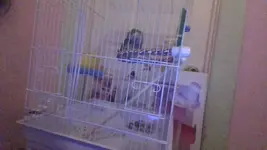MeAndMyQuaker
New member
- Jan 26, 2022
- 3
- 3
- Parrots
- One Green Quaker parrot
Okay so I have a baby Quaker 3 months old (20 weeks old) and I've had him for maybe a little over a month now and I was wondering how long it takes them to get used to their owners?
He's very skittish and doesn't let my hands by him, he won't step up unless I have a treat and it's a wood dowel and I'm just worried I'm doing something wrong.
I was wondering if someone could give me some training tips and things I should start doing (I mean any tips really like, Relationship tips for my bird and me, Training tips, etc) Or any other advice please help!!
More information:
He always screams and he tries to bite me.
I got him on Thursday, December 9th and he was good but loud and wouldn't let me go near his cage (which I was expecting) but this is one month mark with him and he lets me hand feed him spray millet, lets me change his food, water, etc, and he lets me go near his cage, and more. I just wanted to see if anyone knew what to do or expect I want to try teaching him to step up onto my finger but I don't know how or when the right time is, I tried to let him out of his cage for a little bit (I used his wooden dowel to get him out which worked but he tried to go back to his perch) I just don't know what to do and when to do it so can someone please let me know because I love him so much and just wants to do what's best for him. (I also got him from a professional breeder, and he was hand tamed and hand fed and weaned onto Zupreem Seeds but now on Tropican Pellets.)
Tips? Advice? Anything?
It would be greatly appreciated since I'm a beginner bird owner. (but I’ve had some past experience just not my own)
Thank you!
He's very skittish and doesn't let my hands by him, he won't step up unless I have a treat and it's a wood dowel and I'm just worried I'm doing something wrong.
I was wondering if someone could give me some training tips and things I should start doing (I mean any tips really like, Relationship tips for my bird and me, Training tips, etc) Or any other advice please help!!
More information:
He always screams and he tries to bite me.
I got him on Thursday, December 9th and he was good but loud and wouldn't let me go near his cage (which I was expecting) but this is one month mark with him and he lets me hand feed him spray millet, lets me change his food, water, etc, and he lets me go near his cage, and more. I just wanted to see if anyone knew what to do or expect I want to try teaching him to step up onto my finger but I don't know how or when the right time is, I tried to let him out of his cage for a little bit (I used his wooden dowel to get him out which worked but he tried to go back to his perch) I just don't know what to do and when to do it so can someone please let me know because I love him so much and just wants to do what's best for him. (I also got him from a professional breeder, and he was hand tamed and hand fed and weaned onto Zupreem Seeds but now on Tropican Pellets.)
Tips? Advice? Anything?
It would be greatly appreciated since I'm a beginner bird owner. (but I’ve had some past experience just not my own)
Thank you!
Attachments
Last edited:

